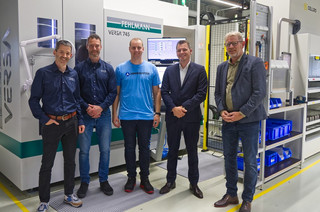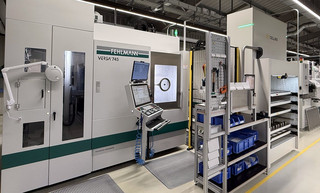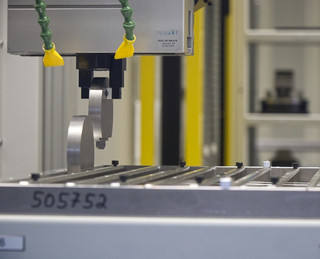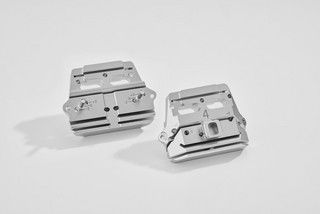Precision meets automation – high-end manufacturing on 61 m²
The requirements in medical technology are high – precision in the micrometer range, absolute process reliability, and maximum flexibility are not optional extras, but essentials. For Armbruster GmbH, a specialist in the manufacturing of medical instruments and implants made of stainless steel and titanium, this is a daily reality. In order to continue producing at the highest level in the future, the company invested in a clever combination: two VERSA 745 5-axis machining centers from Fehlmann AG, connected to the flexible automation system Ultimate from Cellro.
Armbruster GmbH, based in Steinach, is a family-run company now in its second generation. For more than three decades, the medium-sized company has focused on manufacturing highly complex components for medical technology, which accounts for around 60 percent of its sales, as well as precision components for mechanical engineering. The manufacturing spectrum ranges from turn-milling, milling, and eroding to metallic 3D printing and numerous surface engineering processes—such as automated cleaning, blasting, streaming, deburring, and polishing—through to final assembly. All processes are integrated into a certified quality management system in accordance with DIN EN ISO 9001 and 13485.
What sets Armbruster apart is its ability to respond flexibly to changing market requirements – with short lead times, a wide variety of parts, and uncompromising quality standards. In order to uphold this philosophy, even as complexity and automation increase, the company relies on modern technology and long-standing partnerships. One of these has linked Armbruster with the Swiss company Fehlmann AG for decades.
Remaining flexible, delivering precision – every day
"Most of our components are quite demanding. Complex geometries, tough materials such as titanium and stainless steel – everything has to fit perfectly. At the same time, the market expects short delivery times, flexible series sizes and reliable reproducibility ," explains Tobias Armbruster, Managing Director at Armbruster. One example is the economical milling of cutting jig for knee joints for which the experts reached the limits of their manufacturing capabilities. Although it would have been possible to erode the slots completely, this would have been far too time-consuming and costly. For this reason, the slots had to be pre-milled and, in a second step, eroded to the exact geometry and surface quality.
There were also strategic considerations: the growing shortage of skilled workers in Germany, ever shorter lead times, and the expectations of international customers, especially in FDA-regulated medical technology, made it clear that a technological step forward was necessary. The goal was not only to manufacture this specific component, but to establish a solution that would enable Armbruster to produce flexibly, automatically, and in compliance with standards on a permanent basis.
Demanding requirements – limited space
Finding the right solution was anything but easy. The focus was on a 5-axis machining center that offers maximum precision and flexibility, has a zero-point clamping system for controlling pneumatic clamping devices, and still takes up very little space. In addition, a spindle with a speed of over 20,000 rpm was required, ideally with an HSK-A63 interface for stable, low-vibration machining, also with long tools. A swivel range of over 120° was essential in order to machine complex geometries in a single setup wherever possible.
"We needed a machine with at least 120 tool positions, a compact design, and enough power for larger components," recalls Mario Bauer, milling team leader and project manager at Armbruster. "At the same time, it had to be possible to use delicate tools without any problems. High performance in a small space—that was the crux of the matter."
The automation requirements were also high: the company was looking for a system that could automatically change not only workpieces but also clamping devices without human intervention. A wide variety of raw part sizes had to be processed one after the other in unmanned operation. And the whole system had to be implemented in as small a space as possible, with sufficient pallet and gripper spaces for long periods of autonomous operation.
Compact solution – powerful interaction
The solution: two Fehlmann VERSA 745 5-axis machining centers, connected to the flexible automation system, Cellro Ultimate. The compact duo combines high-precision milling, intelligent handling, and reliable processes – all with a space requirement of only 61 m².
The VERSA 745 has it all: a powerful HSK-A63 spindle with 24,000 rpm, a swivel range of up to 135°, a solid gray cast iron portal structure, scraped geometries for maximum dimensional accuracy, and direct-drive rotary axes with torque motors. Even difficult materials such as titanium can be machined precisely and reliably.
"Our customers expect precision, reliability, and efficiency—especially in medical technology," emphasizes Alain Strebel, Head of Sales Northern Europe at Fehlmann. "The VERSA concept was developed precisely for this purpose: stable construction, sophisticated thermal management, and automatic calibration at the touch of a button."
The machine also scores points with its well-designed accessibility and clear separation of the operating and automation sides. "In addition to our standardized automation solutions, we also offer various interfaces for communication with a wide range of systems. We have the necessary expertise in-house, enabling us to provide our customers with comprehensive and competent support during integration," says Alain Strebel.
Separate access for automation on the side facilitates integration and, at the same time, allows ergonomic access to the machine and a clear view of the workpiece.
VERSA machines are perfect for machining complex geometries such as those found on cutting jigs. Armbruster now precisely pre-mills the narrow and deep slots, so that they only need to be finished by eroding. This saves time, reduces costs, and improves the entire manufacturing process.
Intelligent automation – tailored to perfection
This was the first joint project for Fehlmann and Cellro. Contact was established via Armbruster, but the technical coordination took place directly between the teams – from sales to service to engineering. The result: perfect teamwork.
Today, the Cellro Ultimate handles all parts and clamping tools for both machines. Thanks to modular grippers, automatic vice change, and intelligent clamping tool control, everything runs smoothly—even in the tightest of spaces. A special feature - the robot is mounted on a travel rail, allowing it to move flexibly between both machining centers.
One particular sticking point was the cut round raw parts for the cutting jigs – they have to be inserted upright, which many systems are unable to do. Armbruster, therefore, developed its own device for storing the parts, and Cellro amended the software for handling them. The robot now recognizes the exact position and can grip and insert the parts safely – tailor-made for the requirements in Steinach.
"Our automation solutions are designed to adapt to the customer's production reality – not the other way around," explains Christian Dietz, Area Sales Manager at Cellro. "At Armbruster, we integrated the special handling of cut round workpieces directly into the system logic. It is precisely these kinds of adjustments that make the difference."
Everyday life: automated precision in 24/7 operation
The production cell already produces 850 milling hours per month – and the trend is rising. The goal is to reach the 1,100-hour mark. Twenty-four pallet spaces, three grippers, and an auxiliary station allow pallets, products, and clamping devices to be changed during operation – fully automatically.
During commissioning everything also went smoothly. Technicians from Fehlmann and Cellro were on site at the same time, taking care of safety issues such as emergency stop signals and fine-tuning the system, together with Armbruster. Thanks to the familiar Heidenhain control system, operating the machines was no problem, and the Cellro system was also tested with employees at an early stage. "Our operators were involved from the start – we wanted to hear their opinions. The training and acceptance of the cell at Cellro in the Netherlands dispelled many concerns. Today, everyone enjoys working with the solution," says Mario Bauer.
One project, three partners, one language: technology coordinated at eye level
With the new production cell, Armbruster demonstrates how innovation and quality can be combined. The combination of proven machine technology, intelligent automation, and partnership-based cooperation forms a strong foundation—also for future challenges. "We wanted a solution that would grow with us – and we found it," summarizes Tobias Armbruster. "And we found it with partners we can rely on at all times – both technically and personally." The result shows how German manufacturing expertise, Swiss engineering precision, and Dutch automation innovation can shape the future of medical technology manufacturing.
Contact
Armbruster GmbH
Josef-Maier-Strasse 6
D - 77790 Steinach
www.armbruster.com




